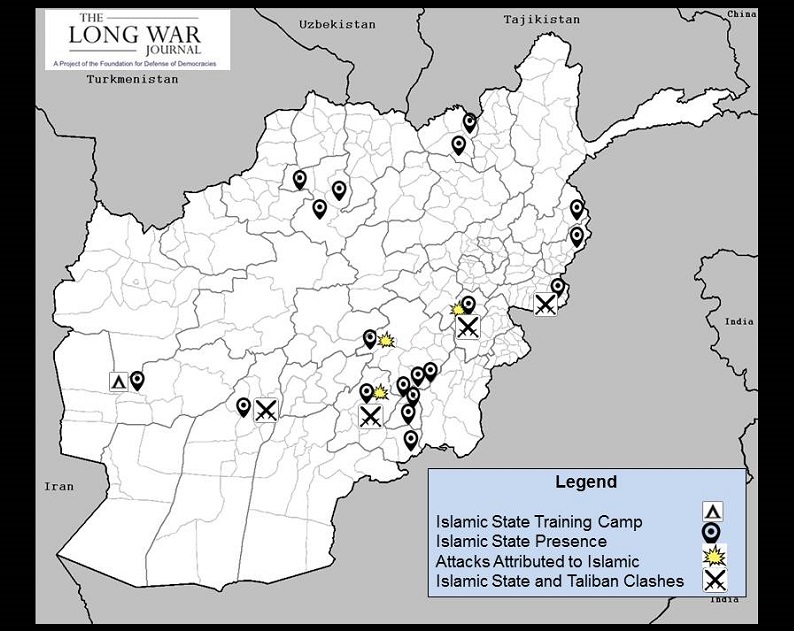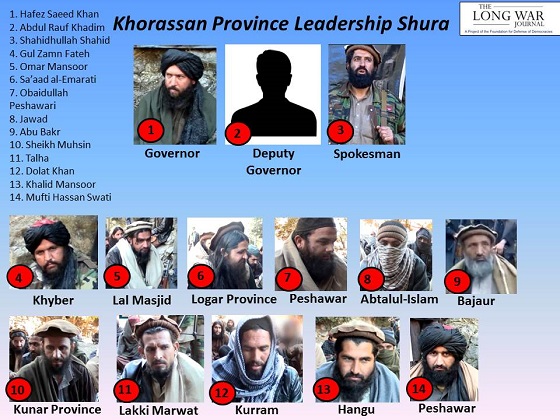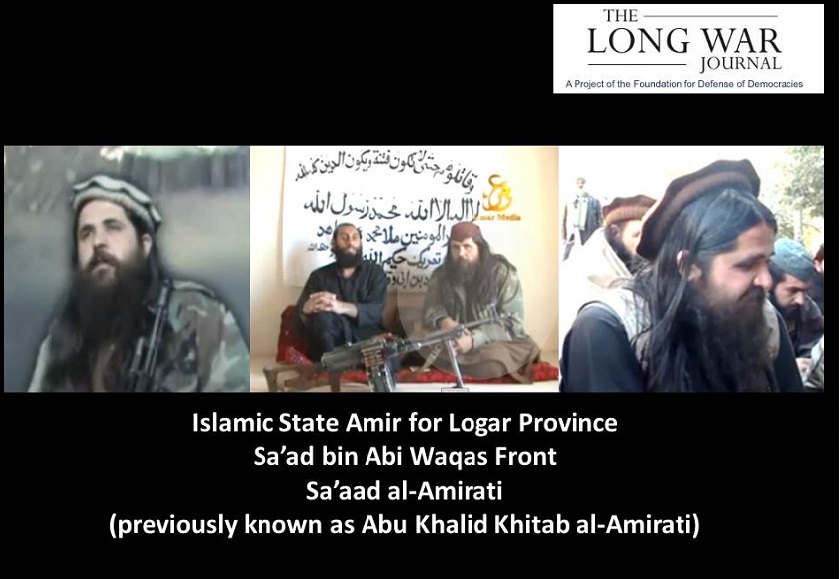Ever since disaffected Afghan and Pakistani Taliban insurgents began pledging allegiance to the Islamic State during the summer of 2014, rumors and reports have emerged indicating how the Islamic State has expanded its presence throughout South Asia. A chronological narrative of the rise of the jihadist group in Afghanistan follows below and the above graphic depicts its emergence.
In late September 2014, fierce battles raged between Afghan security forces and insurgents reported to be associated with the Islamic State in the Arjistan district of Ghazni province. At the time, Afghan officials reported that the insurgents had raised the black flag of the Islamic State and were burning down homes and beheading captured security forces and local residents alike. The incident in Arjistan is mired in controversy, as local Afghan officials allegedly recanted their versions of events and admitted to embellishing the presence of Islamic State fighters as a ploy to obtain more resources, according to a report by The New York Times.
It should also be noted that in early February 2015, the Chief of Police for Ghazni denied that the Islamic State had created a presence in the area, stating that the insurgents fighting against the Afghan Government were local Taliban members.
In mid-October 2014, a small group of disaffected Pakistani Taliban commanders, including the Movement of the Taliban in Pakistan’s Emir for Arakzai Agency, announced their initial pledge to the Islamic State. [See Long War Journal report, Discord dissolves Pakistani Taliban coalition]
In January 2015, the same disgruntled Pakistani Taliban leaders, this time joined by a few little-known disaffected Afghan Taliban commanders, published a propaganda video pledging allegiance to the Islamic State. Within days of the video’s release, the Islamic State announced its expansion into “Khorassan Province” and officially appointed Hafiz Saeed Khan as the Wali (Governor) of Khorassan. The Islamic State also appointed former Guantanamo Bay detainee and senior Taliban leader Mullah Abdul Rauf Khadim as Khan’s deputy. While Khan was primarily responsible for Islamic State activities in the tribal areas of Pakistan, Khadim was based in Helmand province, particularly in his native village located in Kajaki district. It did not take long before clashes broke out between Khadim’s supporters and their rivals belonging to local Taliban factions.
In southwestern Afghanistan, former Taliban insurgents who defected to the Islamic State established a training camp in Farah province in mid-January and were reportedly operating between Bakwa and Khak-e Safid districts. The Islamic State faction in Farah was reportedly led by two brothers, Abdul Malik, who was also known as Mansur, and Abdul Raziq, according to an in-depth report by Pajhwok Afghan News.
Also in mid-January, in northern Sar-i-Pul province, local officials reported that insurgents had raised the black flag of the Islamic State in Kohistanat district and other insurgents had begun recruitment activities on behalf of the jihadist group in the nearby Darzab district of Jawzjan province. Afghan security commanders in Jawzjan later estimated that some 600 insurgents had raised the black flag and were now fighting on behalf of the Islamic State in Jawzjan.
Similar reports emerged from Kunduz province, and the Kunduz governor estimated that nearly 70 insurgents affiliated with the Islamic State had “started activities” in Dasht-e Archi and Chaharadarah districts.
Afghan officials in Ghazni and Paktika Provinces announced in mid-January that hundreds of foreign fighters associated with the Islamic State had recently entered areas of eastern Afghanistan posing as refugees. According to the officials, some 200 foreign nationals had entered the Nawa and Gilan districts of Ghazni and raised the black flag, and 850 families, including Arabs, Pakistanis, and Chechens, had entered Pakitka and Zabul provinces disguised as refugees, some of whom later established households in the Nawbahar, Ab Band, and Shamulzai districts of Zabul.
On February 9, Khadim was killed in a drone strike in Helmand province. [See Long War Journal report, US kills Islamic State’s deputy emir for ‘Khorasan province’ in airstrike.]
A few weeks later, insurgents loyal to the local Islamic State emir for Logar province, Sa’ad al-Amirati, burned down the Khwaja Ali shrine in the Charkh district of Logar. The insurgents also stormed local homes and destroyed television sets, deeming them “unIslamic,” and reportedly killed a local Taliban commander named Abdul Ghani and three of his bodyguards during the same incident, according to Pajhwok Afghan News.
In Nangarhar province, also in mid-February, rival Taliban factions and Islamic State-affiliated insurgents clashed in what was widely reported to be a turf war between the two groups.
In late February, mysterious masked gunmen abducted 31 Hazara travelers in Zabul province. Local Afghan authorities attributed the attack to a wide range of culprits, including the Islamic State, although no group has publicly claimed credit for the attack. After the Afghan Government failed to secure the release of the hostages through negotiations, the Afghan National Army (ANA) launched a rescue operation which reportedly killed dozens of the suspected kidnappers, including foreign fighters from Kyrgyzstan, solidifying earlier reports that foreign fighters associated to the Islamic State had relocated from Pakistan to Zabul.
On March 5, ANA officials reported that a clash between rival Taliban and Islamic State factions in the Arghandab district of Zabul had killed seven Islamic State insurgents; however, further details about the clash could not be ascertained.
Many of the claims and reports concerning the presence of fighters in Afghanistan associated with the Islamic State cannot be easily verified, but the jihadist group’s creation of the “Khorasan Province” in mid-January demonstrates its willingness to expand operations into South Asia. While sectarian agendas among insurgent groups are rare, if not nonexistent, in Afghanistan, it remains unclear whether the Islamic State in Khorasan Province will adopt and implement the sectarian objectives glorified by the group in Iraq and Syria. Similarly, given the numerous clashes between the Taliban and the Islamic State-affiliated insurgents in Afghanistan, the Islamic State will likely continue to face considerable resistance from the spectrum of well-established local anti-state actors like the Taliban, who perceive their resistance to the Afghan Government and coalition forces as the primary and most legitimate alternative to the current political system.
In addition, the Taliban cannot recognize the existence of Abu Bakr al-Baghdadi as the Caliph, in part because Mullah Mohammad Omar, the Supreme Leader of the Taliban, had been deemed Amir ul-Momimeen (Commander of the Faithful Believers) in 1996, a position perceived by Omar’s supporters as superior to Badghdadi’s current role as Caliph. However, the Islamic State has challenged the Taliban and Omar directly, and Baghdadi has described Omar as an “illiterate warlord” and “fool” who does not deserve political or spiritual authority. Omar has not been publicly seen since the US-led invasion of Afghanistan in October 2001. These fundamental ideological conflicts will not be easily reconciled between the Islamic State and the Afghan Taliban.











4 Comments
Excellent information. So I wonder if this ‘cycle/phase’ will ‘chum’ Hekmatyar out into the open? Taking sides or simply pulling an Al Sharpton looking to cash in on some headlines & possibilities. It should be noted that the Taliban was never a choice/option by Pakistan’s ISI. It was foisted upon them by one of Bhutto’s Ministers. Anyone that has taken the time to investigate Mullah Omar’s ascension to “Amir ul-Momimeen (Commander of the Faithful Believers) in 1996” will find that it was not an unanimous decision agreed upon by those who make such determinations in Afghanistan. In fact many of those, by right, who should have been given a voice in the process were denied that. I’m sure, coupled with Mullah Omar’s reclusiveness, this will surface as an issue as challenges to Omar’s Leadership are emerging. I expect Haqqani to stay publicly neutral until many of the other Principals reconcile their differences. I also expect Pakistan’s ISI to move their support to ISIS/ISIL but like Haqqani I don’t think will ‘see’ any evidence of this in the immediate or midterm future, if at all. I also think that the ISI will attempt to broker some kind of truce between the emerging ISIS/ISIL nexus & the existing ‘players’ much as they did during the Soviet Occupation with the Mujhaddeen(spelling?). How that scum bag animal Zawahiri maneuvers his way through this morass should make for some interesting drama.
“While sectarian agendas among insurgent groups are rare, if not nonexistent, in Afghanistan.” But then everything cuts back to Pakistan and they have these Sipah-e-sahaba, Lashkar-e-jhangvi etc. The men, material and training provided by Pakistan is of legendary scale so IS may find some sympathizers there.
Good map.
Just as Al Qaida, the Saudis and now ISI and Taliban have discovered, they have been outflanked for the position of “most extreme fundamentalist in Islam.” Irony that both the Wahabis and Taliban, through very different circumstances, have been discredited by even more extreme elements of the Jihadi-Salafist trend. One could be justified in saying the are getting no more than they deserve for birthing, incubating and then losing control over the whole Islamist movement. Mullah Omar, and Zawahiri – dust bin of History.
1 Trackback